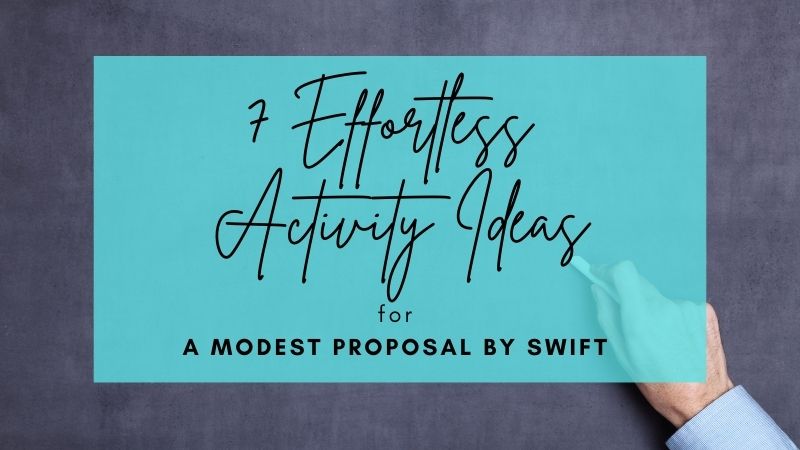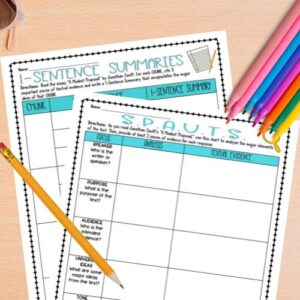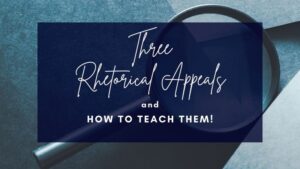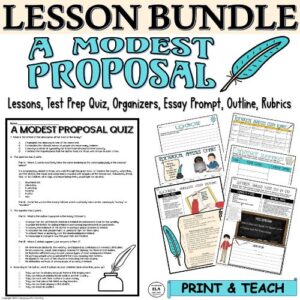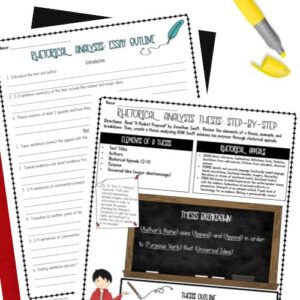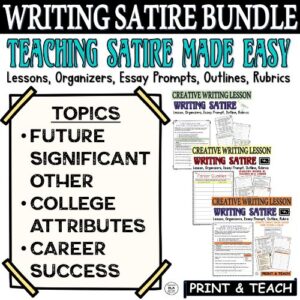Satire is not easy to teach. In fact, I believe teaching satire is a step above teaching rhetoric in general. It usually requires high-level reading skills, background knowledge, comprehension of various tones, and fluency in various forms of syntax. It is tough to understand, let alone examine, analyze, and critique. And so often, our students encounter satire without really understanding what it is. I experienced this feeling in 12th grade as my AP Lang teacher read aloud A Modest Proposal by Swift for the first time.
If you don’t recognize satire for what it really is, you might read Swift’s essay as a grotesque commentary on the consummation, and eventual elimination, of a nation’s children. And of course, I didn’t realize any of this as a senior in high school. My family didn’t watch The Simpsons or listen to satirical news shows. I simply read the literal without considering anything beyond it.
I hope this post below helps as you consider teaching A Modest Proposal by Swift as teaching it is not for the faint of heart!
Need help with Reading Comprehension Testing? Check out this FREE Pack of 3 Test Prep Activities to help students achieve success on standardized tests!

What is Satire?
Before you begin teaching A Modest Proposal by Swift, you might want to define and explain traits of satire.
Satire is a text (written, visual, and/or auditory) that criticizes a person, idea, situation, etc. in order to bring about change in some way.
Characteristics of Satire:
- Irony-usually, the author means directly the opposite of what is said
- Hyperbole-extreme exaggeration
- Tone-author’s attitude within a text
- Understatement-meaning less than what is said
- Purpose-usually involves a change either in action, mindset, or language
- Humor-many pieces of satire incorporate humor throughout
- Structure-typically begins satirically and ends with a realistic solution
7 Effortless Activity Ideas for A Modest Proposal by Swift
1. Teach Summarizing
One might believe that teaching a student how to summarize is easy, BUT I can say with 17 years of experience that it is most definitely not.
Firstly, summarizing requires determining the topic. This process may seem simple, but in the case of satire, it is not. Let’s look at the first paragraph of A Modest Proposal by Swift.
It is a melancholy object to those, who walk through this great town, or travel in the country, when they see the streets, the roads and cabin-doors crowded with beggars of the female sex, followed by three, four, or six children, all in rags, and importuning every passenger for an alms. These mothers instead of being able to work for their honest livelihood, are forced to employ all their time in strolling to beg sustenance for their helpless infants who, as they grow up, either turn thieves for want of work, or leave their dear native country, to fight for the Pretender in Spain, or sell themselves to the Barbados.
You will notice that this introductory paragraph is actually made up of ONLY two sentences. And these sentences are syntactically and lexically complex! If your students are anything like mine, they will struggle with identifying what the author is actually saying. All we know is that the author is talking about familial poverty in a specific country. If students pick this information up, they are getting it!
Secondly, summarizing requires sifting through many details. Who knew that two sentences could say so much?
Thirdly, summarizing requires synthesizing the most important information to develop a central idea statement. A typical American has an average reading level of an upper middle school student (7th-8th graders). Now, if that information is true for an average American, imagine the reading level of an 11th and/or 12th grader. So, we need to model and guide students in their summarizing skills.
Here is an example:
Ex. The writer discusses the major issues involving poverty in Ireland such as the breakdown of the family, unemployment, and crime.
Even if you spend several days reading through, rereading, and summarizing each paragraph of A Modest Proposal by Swift, that is totally okay! Your students will be exposed to satire and grow in their comprehension skills!
2. Teach Vocabulary
Seriously, A Modest Proposal by Swift has an extremely high and more uncommonly used vocabulary that many students, no matter the reading level, struggle with. Taking the time to help students grow their lexicon will never be wasted!
Take a look at the 2nd paragraph of this satire:
I think it is agreed by all parties, that this prodigious number of children in the arms, or on the backs, or at the heels of their mothers, and frequently of their fathers, is in the present deplorable state of the kingdom, a very great additional grievance; and therefore whoever could find out a fair, cheap and easy method of making these children sound and useful members of the common-wealth, would deserve so well of the public, as to have his statue set up for a preserver of the nation.
Can you imagine how overwhelming it must be if you cannot read many words in the above paragraph? So, let students take the time to delve into the meaning and implication of each word they might not know.
Vocabulary Activities:
- Rewrite the Definition-Have students look up the word, write out the definition, and rewrite the definition in their own words.
- Synonyms & Antonyms-Have students look up various synonyms and antonyms for each word.
- Visualize-Have students illustrate a word or several words.
- Write a New Sentence-Have students use the word meaningfully in a new sentence.
When you read widely, you encounter more words you may or may not know. Be sure to invest your time in helping your students grow their own personal vocabulary!
3. Teach Rhetorical Appeals
Feel free to introduce and dig into the three rhetorical appeals as you read A Modest Proposal by Swift: logos, pathos, and ethos.
Logos is an appeal to the audience’s rational thought by using facts and statistics. Swift uses a ton of facts throughout!
Here are some examples of Logos:
- Direct references to sources
- Explanations with factual details
- Definitions
- Facts
- Statistics
Pathos is an appeal to the audience’s emotions through the use of emotional language. Jonathan Swift incorporates emotional descriptions within the entire text.
Here are some examples of Pathos:
- Specific, concrete language
- Varied connotations
- Emotionally loaded language
- Imagery: language that appeals to the five senses
- Narratives or stories of emotional events
Ethos is an appeal to the audience through a belief in the speaker’s authority or credibility. Swift has authority by nature of his heritage, experiences, and education.
Here are some examples of Ethos:
- References to beliefs/experiences the writer/speaker shares with the audience
- Explanations of personal authority or perspective
- Attempts at an unbiased outlook
- Proper level of terminology for an audience
- Writing is grammatically correct
If you introduce these appeals and help students identify examples throughout the essay, they will be set up for analyzing and writing about higher-level texts they encounter in the future!
Check out the post below for help with teaching the three rhetorical appeals!
4. Teach Pre-Writing Skills
One of my favorite ways to introduce students to writing is to prepare them for the process before they even realize what they will be doing. If we spend several periods reading, summarizing, and analyzing A Modest Proposal by Swift, then giving students a writing prompt based on the text will be a much easier task.
I prefer to use S.P.A.U.T.S. as a pre-writing organizer. It gets students thinking about the text by identifying major elements.
S-Speaker: Who is the writer or speaker?
P-Purpose: What is the purpose of the text?
A-Audience: Who is the intended audience?
U-Universal Idea: What are some major ideas from the text?
T-Tone: What is the tone of the author?
S-Strategies: What strategies does the author use to convey ideas?
Now, if you give a prompt about the author’s purpose, strategies used, or central idea, this information will make a student’s job much less difficult to tackle!
5. Teach Test Prep
Most students don’t like standardized tests, and neither do we as teachers! HOWEVER, students need to be prepared for various tests they will encounter throughout high school, college, and the workforce.
Why not make the process fun?
One of my students’ preferred test prep activities is to take practice tests together. You can first assign a quiz to all students, so they get the experience of taking the test individually. Then, I have students work in pairs or groups to discuss answers and come to a consensus for each answer. As a group or pairing, they can submit one quiz for everyone.
Sometimes, I will even tell them how many they got wrong and let them resubmit for a higher grade!
If you make the process of answering questions based on A Modest Proposal by Swift more fun, students will get more excited about participating!
6. Teach Rhetorical Analysis
Rhetorical Analysis writing is probably the most difficult task for high school students. Typically, writing a rhetorical analysis essay does not happen until 10th grade or beyond. Because students are not usually exposed to this type of essay writing in the lower grades, the process of teaching rhetorical analysis for satire (like that of A Modest Proposal by Swift) can be an immense experience.
Therefore, I would not start your students’ rhetorical analysis journey with A Modest Proposal by Swift. There are plenty of other texts you can begin analyzing before you tackle satirical analysis.
When your students do get to the point in the year that they are ready, you might want to think about the following tips:
- Read a satirical text like A Modest Proposal by Swift with your students.
- Give many chances to comprehend the text’s meaning first.
- Provide pre-writing organizers.
- Model how to write a thesis for a rhetorical analysis essay.
- Offer a simple outline for students to follow.
- Include different types of writing: a paragraph, several paragraphs, four-paragraph essays, five-paragraph essays, etc.
- Incorporate a rubric. If students have a rubric, they are more likely to be successful as they write about A Modest Proposal by Swift.
Click below for a ready-made rhetorical analysis pack for teaching A Modest Proposal by Swift!
7. Teach Satirical Writing
Writing satire is a step above writing an argument. Not only do you need to have an argument, but you have to craft it in a way that incorporates various satirical elements. And this procedure is not as hard as it might initially seem to be.
Here are some “proposals” students can make that mimic A Modest Proposal by Swift:
- How to be a wonderful boyfriend or girlfriend
- How to propose to someone
- How to choose a good college
- How to be successful in a career
- How to grow a business
- How to be an amazing parent
- How to be an effective writer
- How to prepare for exams
- How to get a job
- How to create friendships
This sample prompt from this Writing Satire Bundle makes the job simple: What 3 “qualities” do you desire in a future significant other?
I have students prepare for their satirical essays by using these steps:
- Identify 10 qualities (physical, emotional, mental, or spiritual) that you would want in a future significant other. Then, explain with detailed examples why you value these qualities.
- Narrow down the list to 5 of the most important qualities.
- Determine the antonym of each quality. Ex. Hardworking (Good Quality) >>> Lazy (Opposite Quality)
- Craft a thesis by answering the question above.
- Use an outline that guides students sentence by sentence from the introduction to the conclusion.
- Draft each paragraph by using the outline and A Modest Proposal by Swift as a template.
- Refer to the writing rubric BEFORE, DURING, and AFTER the creation of the essay.
After students write their essays, be sure to provide time to share out. So many students want to share their writing either in pairs, small groups, or in the whole class! It makes reading A Modest Proposal by Swift and writing satire that much more fun!
Why teach A Modest Proposal by Swift?
Ultimately, A Modest Proposal by Swift is a capstone text in the genre of satire. If students don’t read it in high school, they will miss out on so many other pieces of satire that connect stylistically or thematically to this seminal work. In fact, if you want your students to read “Sending Grandma to the Ovens,” reading A Modest Proposal by Swift first will make the process go so much more smoothly!
Do your students need help with learning rhetorical analysis like that for A Modest Proposal by Swift? Check out 10 Rhetorical Strategies Any Student Can Easily Learn!

